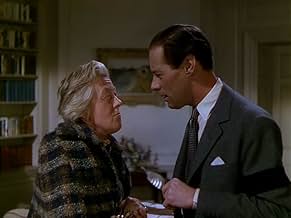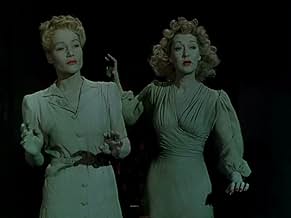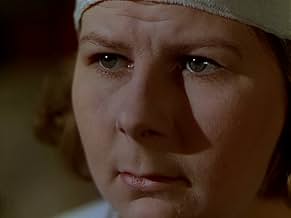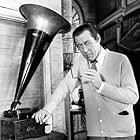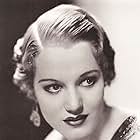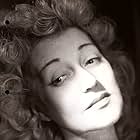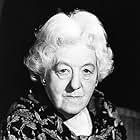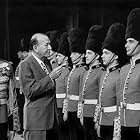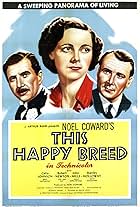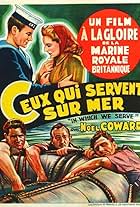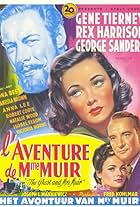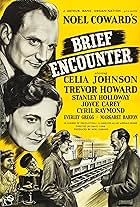NOTE IMDb
7,0/10
8,6 k
MA NOTE
Un homme et sa seconde femme sont hantés par le fantôme de sa première femme.Un homme et sa seconde femme sont hantés par le fantôme de sa première femme.Un homme et sa seconde femme sont hantés par le fantôme de sa première femme.
- Récompensé par 1 Oscar
- 1 victoire et 1 nomination au total
Jacqueline Clarke
- Edith
- (as Jaqueline Clarke)
Marie Ault
- Cook
- (non crédité)
Noël Coward
- Narrator
- (non crédité)
Johnnie Schofield
- R.A.C. Man Directing Traffic
- (non crédité)
Histoire
Le saviez-vous
- AnecdotesWriter and director Sir David Lean and cinematographer Ronald Neame decided not to use double exposure to create Elvira's ghostly appearances. Instead, Lean created an enormous set that allowed Kay Hammond to move freely in each shot. Hammond wore fluorescent green clothes, make-up, and a wig, with bright red lipstick and fingernail polish. Each time she moved, a special light would be directed on her, allowing her figure to glow even in dimly-lit scenes and giving her an otherworldly appearance.
- GaffesAfter the séance, when Elvira first appears, she flops onto the settee by the fire. As her dress billows, it can be seen that the green ghostly makeup ends half-way up her leg, showing normal skin above the makeup line.
- Citations
Charles Condomine: It's discouraging to think how many people are shocked by honesty and how few by deceit.
- Crédits fousThe voice at the end of the credits page that utters, "We are quite, quite WRONG!" is Noël Coward's.
- ConnexionsFeatured in La vraie Miss Marple - L'etrange cas de Margaret Rutherford (2012)
Commentaire à la une
Once again, David Lean adapts a play by Noel Coward, but this time Coward wasn't particularly enamored with the results. The play is set entirely in one room and ends a particular way, but Lean expanded the visual scope of the film to include action outside the room and offered up a different ending that is a more ironic twist on events than the original. It's a witty little affair about a widower, his new wife, and the ghost of his first wife coming to visit.
Charles is married to Ruth, and their marriage seems to be a happy one. They tease each other about their previous spouses, both of whom had died, but they are dedicated to each other. Charles is setting out to write a mystery novel and invites over a few friends to witness the work of Madame Arcati, the local medium, to come for dinner and a séance. Perhaps because of the red meat she ate at dinner or because of some random thought at the back of Charles' mind, Madame Arcati opens the door for Elvira, Charles' first wife, to come to the mortal realm as a specter that only Charles can see.
The effect of Elvira's presence is mostly done with green makeup that matches her green gown and red lipstick and fingernail polish. It's slightly reflective so it pops a bit more on screen than everything around her, and it's a fine solution for how to capture a ghost on screen considering the amount of work it would have been to convincingly do double exposures for the amount of time the characters interact. And yet, it still feels somewhat flatly theatrical instead of cinematic, only providing small moments where people pass through Elvira or she carries a potted plant across the room. For all the effort to make her pop on screen, she still feels very physical in her presence, a problem that might have been impossible to fix at the time.
Still, the effect of the movie isn't visceral, relying so heavily on witty dialogue between its four stars. Charles' response to Ruth's questioning of his past brings out a fun line about how Charles will consult his diary for the history of his sex life and get back to her after lunch, for instance. The whole haunting flips on its head when Ruth ends up dead, accidentally at the hands of Elvira who used her ghostly powers to cut the brakes on Charles' car intending for Charles to die and spend eternity with her. Suddenly, Elvira is haunted by Ruth in a way that resembled Charles being haunted by Elvira without Ruth being able to see. It's a witty twist to the situation, and a lead in to the film's ending act that sees the return of Madame Arcati as she tries to send both back to the afterlife in a series of entertaining failures that does more to return Ruth to Charles' vision than anything else.
Now, haunted by both of his dead wives, Charles is trapped, exasperatingly so. The situation has left him jaded about death and the loss of his spouses, and when Madame Arcati does eventually get them sent back to where they came, Charles feels free. This is where the play and film are different, apparently. The play sees him simply escape with his life, free of his wives, but the movie adds a new ending where Charles dies on the same bridge that Ruth died on in an ironic twist that sees Charles spending the rest of eternity with both Ruth and Elvira.
It's an entertaining little morsel of fun from Coward and Lean, something that uses the occult in an entertaining way and is filled with witty, fun dialogue. It's not my favorite screwball comedy (that would probably be Bringing Up Baby), but it's certainly a highlight.
Charles is married to Ruth, and their marriage seems to be a happy one. They tease each other about their previous spouses, both of whom had died, but they are dedicated to each other. Charles is setting out to write a mystery novel and invites over a few friends to witness the work of Madame Arcati, the local medium, to come for dinner and a séance. Perhaps because of the red meat she ate at dinner or because of some random thought at the back of Charles' mind, Madame Arcati opens the door for Elvira, Charles' first wife, to come to the mortal realm as a specter that only Charles can see.
The effect of Elvira's presence is mostly done with green makeup that matches her green gown and red lipstick and fingernail polish. It's slightly reflective so it pops a bit more on screen than everything around her, and it's a fine solution for how to capture a ghost on screen considering the amount of work it would have been to convincingly do double exposures for the amount of time the characters interact. And yet, it still feels somewhat flatly theatrical instead of cinematic, only providing small moments where people pass through Elvira or she carries a potted plant across the room. For all the effort to make her pop on screen, she still feels very physical in her presence, a problem that might have been impossible to fix at the time.
Still, the effect of the movie isn't visceral, relying so heavily on witty dialogue between its four stars. Charles' response to Ruth's questioning of his past brings out a fun line about how Charles will consult his diary for the history of his sex life and get back to her after lunch, for instance. The whole haunting flips on its head when Ruth ends up dead, accidentally at the hands of Elvira who used her ghostly powers to cut the brakes on Charles' car intending for Charles to die and spend eternity with her. Suddenly, Elvira is haunted by Ruth in a way that resembled Charles being haunted by Elvira without Ruth being able to see. It's a witty twist to the situation, and a lead in to the film's ending act that sees the return of Madame Arcati as she tries to send both back to the afterlife in a series of entertaining failures that does more to return Ruth to Charles' vision than anything else.
Now, haunted by both of his dead wives, Charles is trapped, exasperatingly so. The situation has left him jaded about death and the loss of his spouses, and when Madame Arcati does eventually get them sent back to where they came, Charles feels free. This is where the play and film are different, apparently. The play sees him simply escape with his life, free of his wives, but the movie adds a new ending where Charles dies on the same bridge that Ruth died on in an ironic twist that sees Charles spending the rest of eternity with both Ruth and Elvira.
It's an entertaining little morsel of fun from Coward and Lean, something that uses the occult in an entertaining way and is filled with witty, fun dialogue. It's not my favorite screwball comedy (that would probably be Bringing Up Baby), but it's certainly a highlight.
- davidmvining
- 14 sept. 2020
- Permalien
Meilleurs choix
Connectez-vous pour évaluer et suivre la liste de favoris afin de recevoir des recommandations personnalisées
Détails
- Date de sortie
- Pays d’origine
- Langues
- Aussi connu sous le nom de
- Un espectro travieso
- Lieux de tournage
- Denham Mount, Blacksmith's Lane, Denham, Uxbridge, Buckinghamshire, Angleterre, Royaume-Uni(Condomine House, exteriors)
- Sociétés de production
- Voir plus de crédits d'entreprise sur IMDbPro
Box-office
- Montant brut mondial
- 169 $US
- Durée1 heure 36 minutes
- Couleur
- Rapport de forme
- 1.37 : 1
Contribuer à cette page
Suggérer une modification ou ajouter du contenu manquant






